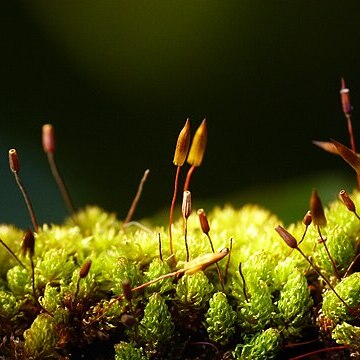Plants medium-sized to large, forming mats, green, yellowish green, brown-green, or yellow-brown above, brown below; saxicolous or corticolous. Primary stem up to 140 mm long, branching regularly, tomentose below; rhizoids smooth, red-brown; secondary stem erect, 2-40 mm tall, branching by subperichaetial innovations; in section inner cortex 10-16 cells across, incrassate, outer cortical cells smaller, in 2-5 rows, incrassate, substereids or stereids, outer surface rough. Stem leaves crowded to ± distant, fragile on old stems; ovate-acuminate, ovate-lanceolate or ovate-subulate, 1.0-2.4 mm long. Branch leaves crowded, erect, spirally twisted to contorted when dry, erect-spreading, frequently reflexed, flexuose when wet, rugose, unistratose; narrowly lanceolate, narrowly oblong-lanceolate or narrowly oblong-subulate, 2.7-4.8 mm long, keeled; apex acute to acuminate; margins plane, occasionally reflexed below, irregularly denticulate above, plane or prorate to tuberculate below. Costa ending below apex to mucronate; ventral and dorsal superficial cells linear, smooth; in section crescent-shaped to subround, bulging dorsally, guide cells incrassate or substereids, dorsal stereids present. Upper laminal cells rounded or rounded-hexagonal, incrassate, bulging, frequently in conspicuous longitudinal rows, 7.5-18.0 µm, mammillose to strongly mammillose; basal cells long-rectangular, longitudinal walls irregularly incrassate, pitted, tuberculate, marginal cells frequently thinner walled, inflated, smooth or prorate to tuberculate. Pseudautoicous; dwarf male plants rare, on branch leaf lamina. Perichaetia terminal, frequently overgrown by subperichaetial innovations; leaves oblong-lanceolate or oblong-subulate, 3.2-4.4 mm long. Seta 4.5-14.0 mm long, yellowish brown or reddish brown to brown. Capsule reddish brown to brown, ribbed; urn ovate-cylindrical, 1.0-1.6 mm long; neck to 0.5 mm long; exothecial cells irregular in shape, smaller at mouth, incrassate; annulus deciduous, cells subrectangular. Peristome double, erect when dry; exostome teeth fused, blunt, frequently fragile above, 170-225 µm long, yellow-brown to brown, densely papillose-striolate; basal membrane high, hyaline, papillose, segments and cilia absent. Operculum 1.0-1.2 mm long. Calyptra 3.0-3.6 mm long, lacerate to base of rostrum, essentially naked, yellow to yellowish brown or reddish brown. Spores 17.0-36.5 µm, minutely papillose; anisosporous.
More
Plants medium-sized to large, forming mats, green, yellowish green, brown-green, or yellow-brown above, brown below; saxicolous or corticolous. Primary stem up to 140 mm long, branching regularly, tomentose below; rhizoids smooth, red-brown; secondary stem erect, 2-40 mm tall, branching by subperichaetial innovations; in section inner cortex 10-16 cells across, incrassate, outer cortical cells smaller, in 2-5 rows, incrassate, substereids or stereids, outer surface rough. Stem leaves crowded to ± distant, fragile on old stems; ovate-acuminate, ovate-lanceolate or ovate-subulate, 1.0-2.4 mm long. Branch leaves crowded, erect, spirally twisted to contorted when dry, erect-spreading, frequently reflexed, flexuose when wet, rugose, unistratose; narrowly lanceolate, narrowly oblong-lanceolate or narrowly oblong-subulate, 2.7-4.8 mm long, keeled; apex acute to acuminate; margins plane, occasionally reflexed below, irregularly denticulate above, plane or prorate to tuberculate below. Costa ending below apex to mucronate; ventral and dorsal superficial cells linear, smooth; in section crescent-shaped to subround, bulging dorsally, guide cells incrassate or substereids, dorsal stereids present. Upper laminal cells rounded or rounded-hexagonal, incrassate, bulging, frequently in conspicuous longitudinal rows, 7.5-18.0 µm, mammillose to strongly mammillose; basal cells long-rectangular, longitudinal walls irregularly incrassate, pitted, tuberculate, marginal cells frequently thinner walled, inflated, smooth or prorate to tuberculate. Pseudautoicous; dwarf male plants rare, on branch leaf lamina. Perichaetia terminal, frequently overgrown by subperichaetial innovations; leaves oblong-lanceolate or oblong-subulate, 3.2-4.4 mm long. Seta 4.5-14.0 mm long, yellowish brown or reddish brown to brown. Capsule reddish brown to brown, ribbed; urn ovate-cylindrical, 1.0-1.6 mm long; neck to 0.5 mm long; exothecial cells irregular in shape, smaller at mouth, incrassate; annulus deciduous, cells subrectangular. Peristome double, erect when dry; exostome teeth fused, blunt, frequently fragile above, 170-225 µm long, yellow-brown to brown, densely papillose-striolate; basal membrane high, hyaline, papillose, segments and cilia absent. Operculum 1.0-1.2 mm long. Calyptra 3.0-3.6 mm long, lacerate to base of rostrum, essentially naked, yellow to yellowish brown or reddish brown. Spores 17.0-36.5 µm, minutely papillose; anisosporous.

